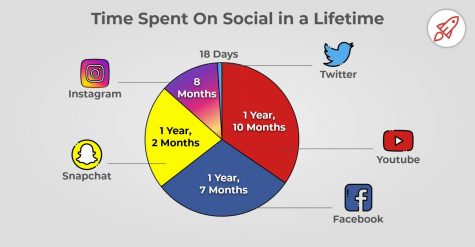Could you go screenless for 24 hours?
May 25, 2021

As technology and screens become a growing need in our everyday lives, the idea of going screenless seems like an impossible task. We rely so much on technology throughout our lives, especially during the pandemic.
For the remainder of the 2019-20 school year and for much of this current school year, all schoolwork has been found online. The way we attended class was through computers and phones, not to mention our only mode of communication during the pandemic was technology.
We’ve become a technologically-dependent society, and while the amount of time we spend on screens can become a negative, some positive aspects of technology can be immensely helpful to students. For example, students can connect with one another and talk, as well as do school work on their phones. Generation Z is also the very first generation to have this advanced technology since birth, as it has become heavily incorporated into our functionality from a young age, “We grew up with technology,” Junior Anna Malik said. “We’re just so used to having that access whenever we want/need.”
Many teens feel the same way as Malik because they are used to having phones with them and the whole internet at their fingertips. It would be incredibly difficult to give all of this up for 24 hours. Junior Lily Glowskinski added, “Unlike older generations, people our age, myself included, have become accustomed to having our technology with us all the time.”
Many students struggled not having their phones for a few hours while taking a standardized test, so going an entire day would be quite the task. Sophomore Mallory Armstrong thinks she could go screenless for 24 hours, but she wouldn’t by choice.
Most of us can understand this; we have the capability to go screenless. Armstrong added, “My phone makes things easier and lets me contact people if I need to.” Our main form of communication to friends when we aren’t at school is through phones. Especially during a pandemic when most places are closed down, having phones is a main way to communicate with friends and family.
When adults are asked to do this, they have some incentive—most of the time it is money. This is to motivate people to not use technology for a whole 24 hours.
Some companies are willing to pay participants $2,400 for you to go screenless for 24 hours. They are calling it the Digital Detox Challenge. If you are addicted to technology then this challenge is perfect for you; it is the perfect opportunity to go screenless and disconnect from technology.
Most people only go screenless for 24 hours only because they know that at then end of the day they will be rewarded for their actions. However, when Malik was asked if she would need an incentive for the 24 hours, she responded: “I mean, I’d do a lot of things for a gallon of ice cream.” Malik would spend her 24 hours riding her bike, painting, making friendship bracelets, and reading, as well as catching up on some much needed sleep.
The biggest concern for students going screenless would be the lack of communication with friends. “If I went screenless for 24 hours, I’d miss how easy it is to communicate with people,” Glowskinski explained. “Since we’re still in a pandemic, most of my social interactions come from texting.” Many agree with her because when we were all stuck at home, our only way of communicating was through our phones and technology. Technology has become an increasing importance in our lives.
With our lives revolving around technology, we find that we spend a lot of time on our phones in particular. It can pull us away from other important things in our lives. “ I often procrastinate my schoolwork by going on my phone or watching Youtube,” Glowskinski shared. “If going on my phone wasn’t an option, I’d be more likely to get my schoolwork done.”
Glowskinski is not alone; 80% of high school students are distracted with technology and it gets in the way of schoolwork. Students get very distracted and end up prioritizing phone time instead of studying. Teens tend to go on our phones and scroll through apps like TikTok and Instagram for hours on end instead of prioritizing our schoolwork.
It is also proven that watching TV or YouTube while doing homework is significantly less effective than focusing on the schoolwork itself. Many students are guilty of this because when given the option, most wouldn’t choose homework.
When asked, most students would go screenless for 24 hours if it was the only option; however, they wouldn’t just give it up for the day just because. Our society has grown accustomed to having technology with us at all times, and we need to pull away from that.
Yes, technology is convenient and makes our lives easier, but it takes time away from teens going outside and participating in hobbies they actually enjoy like reading, arts and crafts, being outside, and playing with family pets. Students spend about five to seven hours a day on their phones alone. This doesn’t even include all of the time students spend on computers and the TV.
Going screenless would be the ultimate test on how much our society is technology-based, and how much we rely on technology in our day-to-day lives. Could you go screenless for 24 hours by choice, or would you need an incentive?